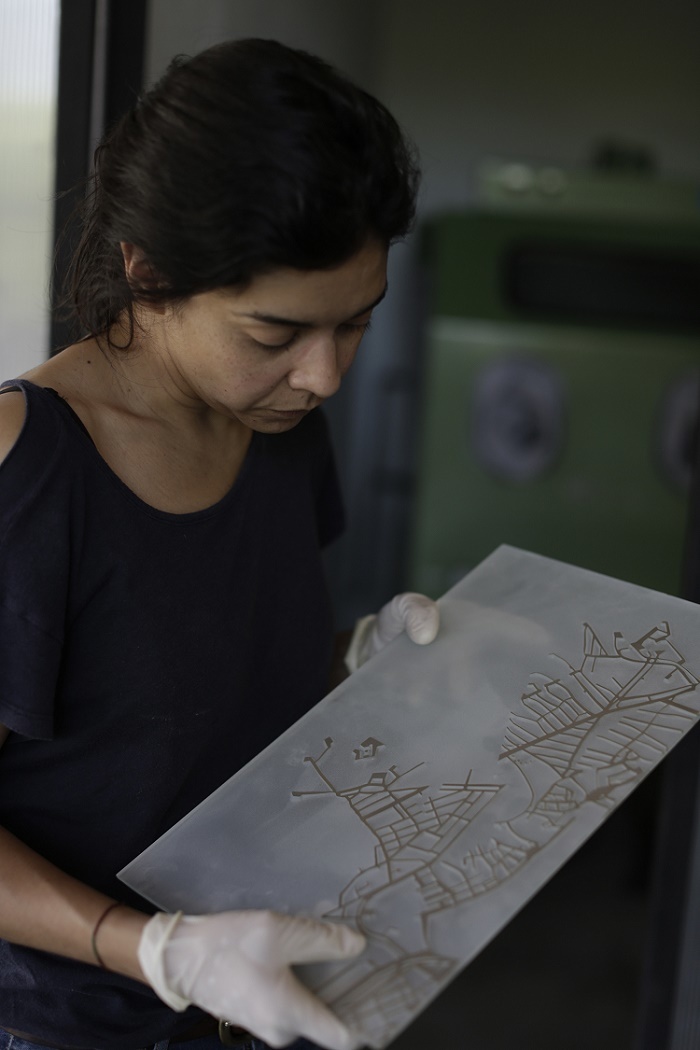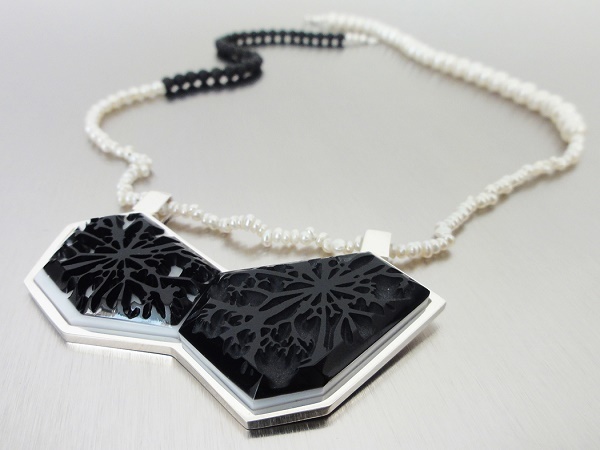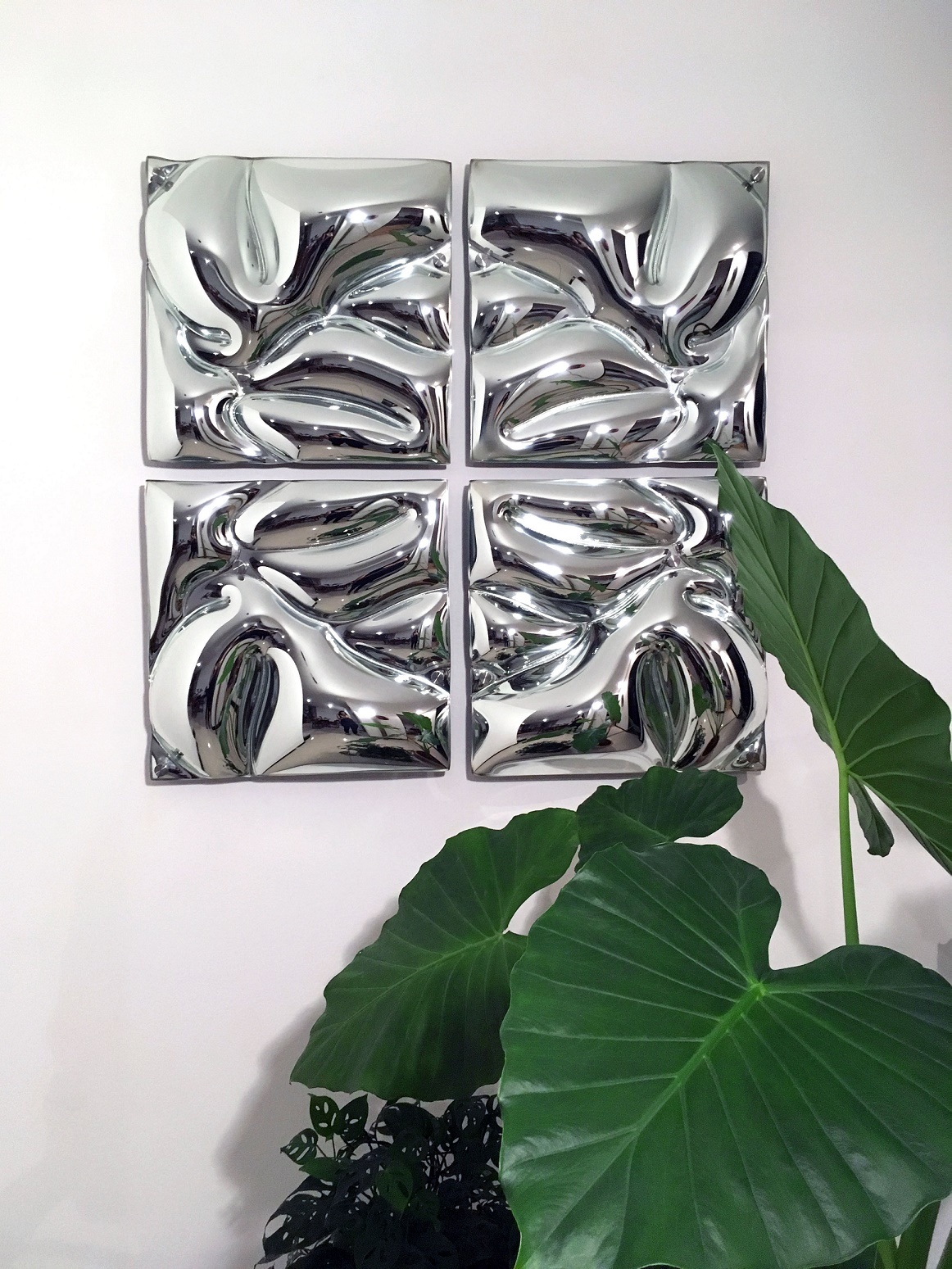Mexico City has always been a place of craft and in recent years that reputation has expanded as fine artists from everywhere flock to the city. Colombian glass artist, Luisa Restrepo works out of her studio "El Taller" in one of the city's oldest neighborhoods, The Guerrero. Much of her work is made from reused glass that she "upcycles," totally transforming what we might call "waste" into high-end design and jewelry pieces. Last summer, Restrepo taught a class at Urban Glass called Shift, which was based upon this idea of the reusability of glass. Restrepo has been exploring ideas of excess and obesity in her more conceptual work, finding fascination in our changing reality as a reflection of the changing physical form.
The Urban Glass Art Quarterly's Hot Sheet spoke with Restrepo for insight into her jewelry project as well as her more conceptual work.
Glass Quarterly Hot Sheet: What are you currently working on?
Luisa Restrepo: I am currently working on two design projects and a jewelry collection: Ciudad radiada is a collection of mirrors using urban morphology as a way of personalizing the piece. With the client we create an urban pattern-collage combining different places that are part of his or her life, printing a personal memory on the object.
Circuito is a lighting collection I am developing in collaboration with the Mexican designer Aitor Garrido. They are geometrically simple, a combination of lines and circles inspired by the transmission of electricity, resembling a circuit. For the collection we are developing a set of components that can be assembled differently to adjust to the needs of the space and client.
The principle of both design projects is to generate mechanisms to more easily customize the pieces, hoping to promote a different kind of relationship between the owner and its objects. We are also looking to support the network of local, small and medium sized artisan shops.
Mexico is known for its excellent craft work but with the proliferation of mass production some of the guilds are slowly disappearing. The coupling of a skilled, specialized, and affordable workforce with independent designers (more interested in smaller, carefully made editions) has been advantageous for both parties, and is slowly shaping Mexican contemporary design.
Shift is a jewelry collection in progress right now. Glass-makers and especially kiln workers tend to save the residue and waste generated by every project.
For this collection, instead of using raw material, the idea is to use this ‘discarded glass’ as a starting point.
In December of last year I decided to take collected waste to make a number of jewelry pieces using no other added materials. It was fun, challenging, and I believe pretty successful. The pieces in no way had a recycled look and I came to conclusions that were pretty different from my usual work.

Glass: What was your original impetus for working with reusable materials? Was there a particular moment in your life that stimulated this artistic decision?
Restrepo: I guess my original impetus for reusing glass was the beauty of the material (even in waste form). At university I used to collect broken shards left by the glass blowers (who were just learning, so there were a lot of broken bits), flatten them on a kiln and make either jewelry, wall installations, or put them in my hot cast pieces. Then when I opened my studio any large piece that didn’t survive the making would become smaller pieces or jewelry. Glass is too expensive to throw away. But all of this recycling was done more spontaneously, usually just downsizing more than transforming.
The catalyst for what became my more conscious use of waste as a statement, arose during my masters degree, When I engaged in my first upcycling project in which I had to create a musical instrument. I went around bars and restaurants, collected one too many bottles and experimented for some weeks until I had not one, but five different satisfying musical instruments. It was a fun challenge. But by the end of it I had quite a number of left over cut bottles that seemed a shame to throw away, so instead I designed the Bottle Top jewelry collection, and the Pills to Rest your Mind piece.
From this point on, what changed was my approach to discarded glass. Instead of waiting for an idea to pop-up, I gathered the material and through the design process worked with it until I achieved results. Looking back I would say my artistic decisions were stimulated by a combination of admiration, availability, and necessity.
Glass: Where do you source the glass from?
Restrepo: I source the raw material from different places depending on the project. I mainly use Bullseye glass but in recent years have also worked with window glass for the slumped mirrored panels/pieces in my project Proportion of Excess and mirrored blown borosilicate glass for my jewelry collection Not Arbitrary. I used collected bottles from neighboring restaurants and bars for the Bottle Top jewelry collection, and now wasted materials from my own home for the Shift collection. It really varies for me.

Glass: How did your work inform what you taught at Urban Glass last August? Why was the class titled Shift, the name of your personal project you previously mentioned?
Restrepo: As I mentioned before, the title Shift refers to a displacement of the starting point in the designing of a jewelry collection. And the idea of the class, better described as a design challenge, is that by implementing some of the design thinking exercises I used in my creative process, I had the students working out of their comfort zone, realizing the hidden potential in waste materials and arriving at different places than they normally do.
Glass: Could you speak a little bit about how the class went at Urban Glass?
Restrepo: What I appreciate most about this specific class structure is how different each student approaches the challenge, the diverse paths they take and the variety of solutions they come up with.
Some students took interest in bits and pieces of glass that I had considered dead ends, something that broadened my scope of the potential of waste material, giving me a set of new ideas on how to use my own. In terms of body adornment there were interesting proposals on wearables that have had an impact on a collection I am now developing.
Glass: Having read a little bit about both your projects (your jewelry collections and your conceptual body of work on obesity, Proportion of Excess), I see that they are conceptually similar in that they are both interested in ideas of overconsumption. Would you say this is true? Do you think your two projects have concepts in common as you work on each simultaneously?
Restrepo: Both projects touch on the concept of excess, but they are very different approaches to the subject.
Proportion of Excess explores the concept, using images of morbid obesity and mirrors as metaphors. It is a ‘reflection’ on how excess (of any kind) changes our reading and understanding of that and those around us.
The jewelry project is a commentary on the short life of a product that takes a lot of time and energy to be produced. Capitalism thrives on overconsumption and, as a result, overproduction and excessive waste. By giving the product a second life in a completely different setting I wish to highlight the potential of objects we normally see as trash and the importance of prolonging a product’s lifecycle.

Glass: Would you say that glass is an ideal medium for what you want to express about excess, the human condition and our shifting views of the reality around us?
Restrepo: I believe the concept of excess can be approached with any medium. It took almost a year before glass became part of my body of work, Proportion of Excess and it wasn't my intention to use the material when I started my research.
At the beginning I only worked with manipulated photographs and drawings, then I did wall installations using printed images on vinyl. Later, hoping to expand my visual repertoire, I looked at documentaries about morbid obesity. My intention was just to take screen captions, but after watching some of the videos my interest shifted from the obese body itself to the environment that surrounded it and somehow nursed it. And that is when I started using slumped mirrors, it was a good way of materializing my thoughts. But the work led me there, it didn't start there--my goal wasn't to necessarily use glass for the project. However, because glass is the medium I am most familiar with, it's no surprise it allows me to reach conclusions.





